Reports
Print Ledger Report
-
Go to GL > Print Ledger Report > Select your date
-
Filter by account, project, area, agent (optional)
-
Tick whether you want to view General Ledger, Sales Ledger (Customer) or Purchase Ledger (Supplier)
-
System can generate reports by group and provide a summary for each group (Group/Sort by)
-
In Option Upper Level
- Merge GL Code for same document – If you have the same account in one single transaction, the system will automatically merge, if you want to separate the account code for the same document, please un-tick.
- Exclude Project when merging – Exclude the project when merging GL Account.
- Use second description – Use second description which is maintained under GL > Maintain Chart of Account.
- Include Zero Closing Balance – Choose to show accounts in the report even if their amount is 0.
- Include Zero Transaction – Choose to show accounts in the report even if there are 0 transactions.
- Local Currency & Foreign Currency – If you have foreign currency transactions, you can tick the foreign currency so that the system will show the figures in foreign currency compare versus local currency.
- Apply
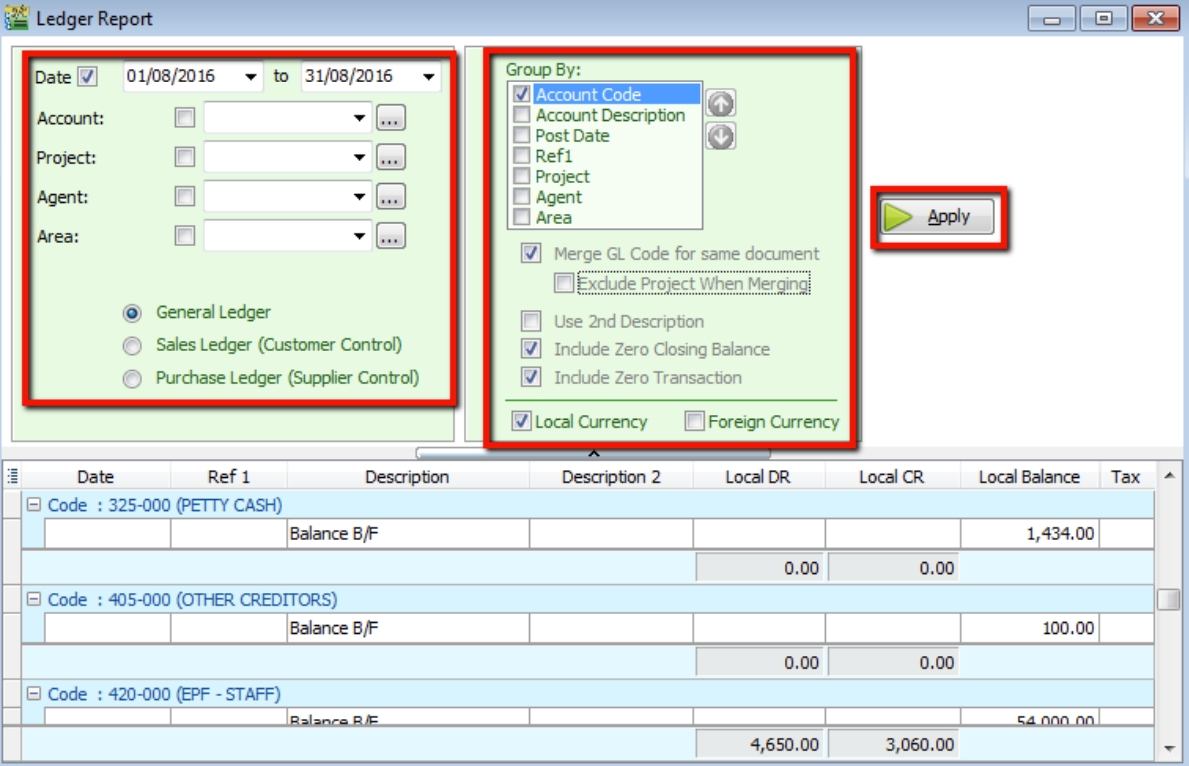
Print Balance Sheet Statement
-
Go to GL > Print Balance Sheet Statement > Select your date
-
Choose your preferred format
-
“Show Up to Level” under Option refers to the depth of sub-accounts in your Maintain Chart of Account, the higher the value, the more level of detail will be shown.
-
In Option Upper Level
-
Use second description – Use second description which is controlled at GL > Maintain Chart of Account.
-
Zero Balance Account – Choose to show accounts in the report even if their amount is 0.
-
Display Trade Debtor/Creditor in Details – Show detailed information for each customer account.
-
-
In Option Bottom Level
-
Print Sub Account Only – Select a certain account to view.
-
Print Project Comparison – You are allowed to view your report by project (project module requested).
-
Show Column Options – You can preset setting as attached.
-
-
Apply
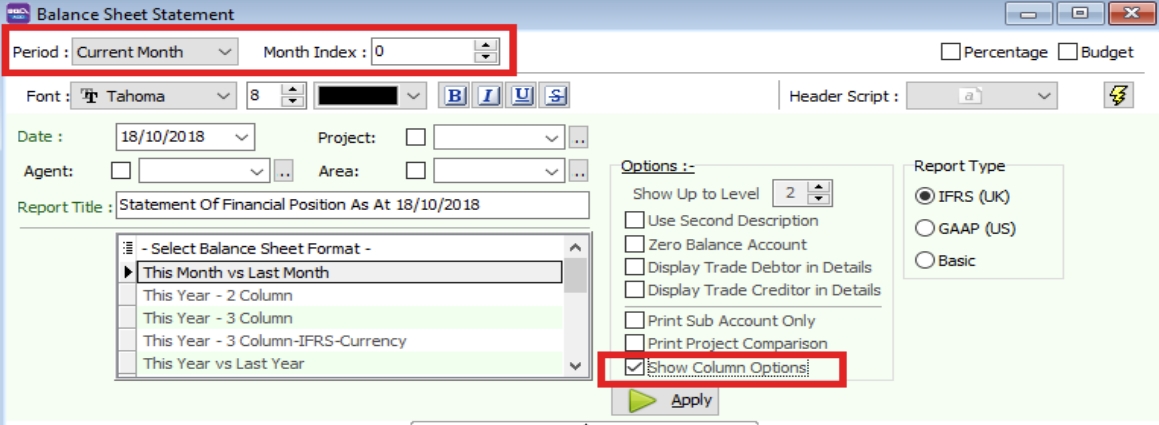
Print Profit & Loss Statement
-
Go to GL > Print Profit & Loss Statement > Select your date
-
Choose your preferred format
-
In Option Upper Level
-
Use second description – Use second description which is maintained under GL > Maintain Chart of Account.
-
Zero Balance Account – Choose to show accounts in the report even if their amount is 0.
-
-
In Option Upper Level
-
Print Sub Account Only – Select a certain account to view.
-
Print Manufacturing Account – You are only allowed to view manufacturing account if you have set it up under Maintain Chart of Account.
-
Print Project Comparison – You are allowed to view your report by project (project module requested).
-
Show Column Options – refer Balance Sheet
-
-
Apply

Print Profit & Loss Statement (Consolidation)
-
Consolidation refers to the aggregation of financial statements of a group company as consolidated financial statements.
-
New add-on module name : Financial Consolidation.
-
Quick summary of setup the group of companies database list to be displayed in Profit & Loss Statement.
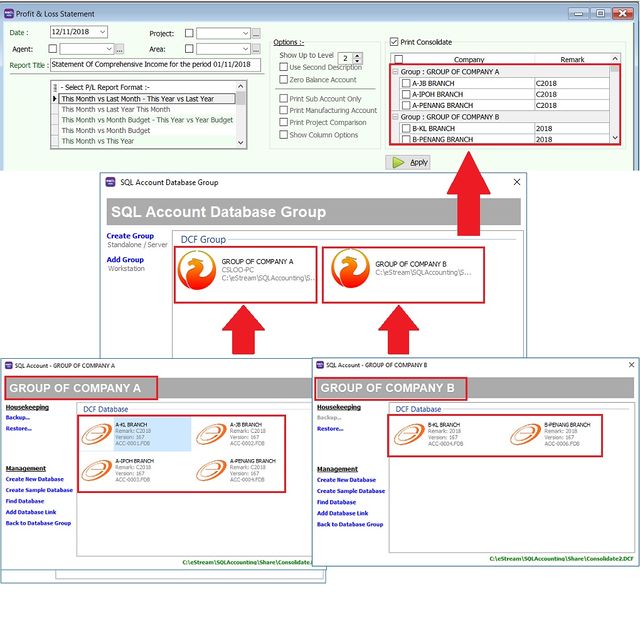
-
Tick Print Consolidate.

-
Select (tick) on the company name from different Groups of Companies.
-
Click Apply.
-
It will merge the financial data from the companies selected. Represent a Short Company Name for each company.
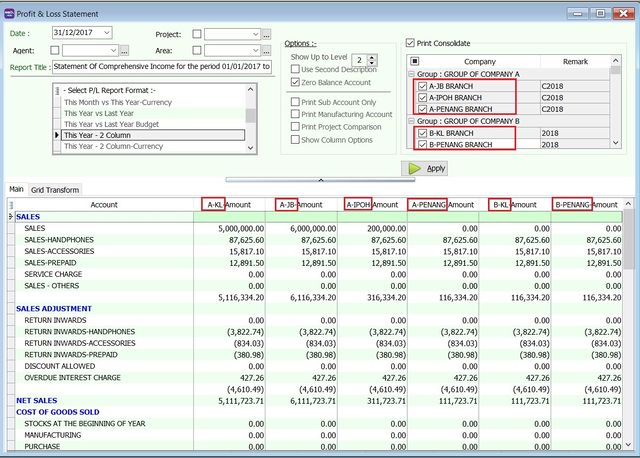
-
Short Company Name will be display in the grid column when you apply the Financial Consolidation.
-
It can be defined in File | Company Profile... (More tab).
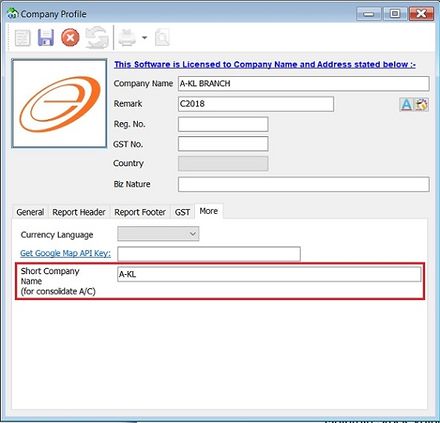
Print Trial Balance
-
Go to GL > Print Trial Balance > Select your date
-
Filter by project, area, agent (optional)
-
Tick whether you want to view General Ledger, Sales Ledger(Customer) or Purchase Ledger (Supplier)
-
In Option Upper Level
-
Use second description – Use second description is which maintained under GL > Maintain Chart of Account.
-
Zero Balance Account – Choose to show accounts in the report even if their amount is 0.
-
-
Apply
